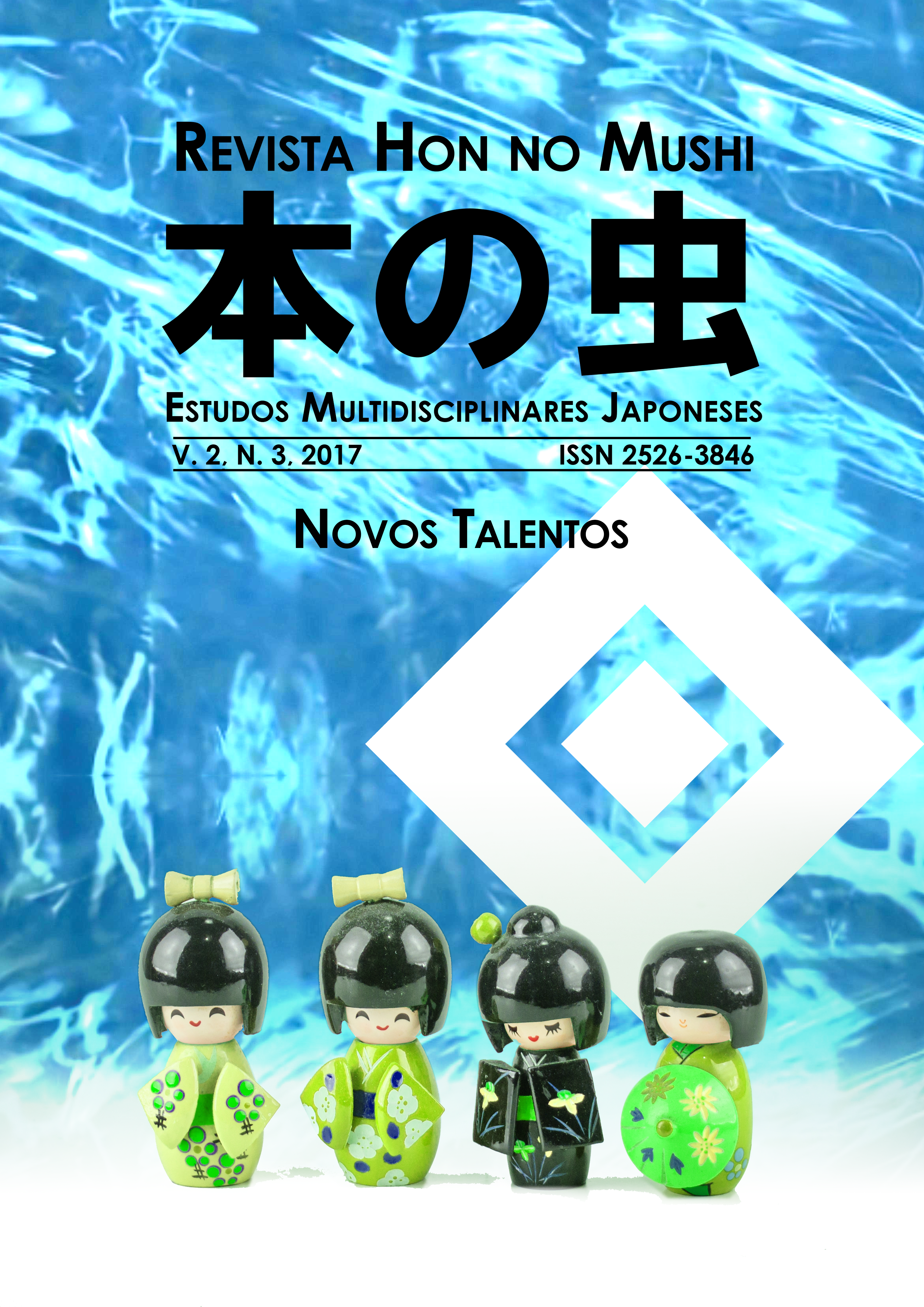JOÃO RODRIGUES TÇUZU E SUA OBRA NIHON KYŌKAISHI
Palavras-chave:
João Rodrigues Tçuzu, Nihon kyōkaishi, Japão, Século Cristão, NanbanjinResumo
O artigo busca apresentar e refletir sobre vida e obra Nihon kyōkaishi (“História da Igreja no Japão”) do intérprete e jesuíta português João Rodrigues Tçuzu, que a serviço direto dos unificadores Toyotomi Hideyoshi, Tokugawa Ieyasu, e do Visitador Geral Alessandro Valignano, foi testemunha ocular das diversas transformações socio-econômicas ocorridas no arquipélago. Motivo pelo qual estudaremos sua obra, em especial a descrição do cha no yu (cerimônia do chá), por meio das lentes da Micro-história buscando compreender como a formação do Japão moderno foi visto pelos primeiros estrangeiros durante o dito Século Cristão (1543-1643) e quais foram seus desdobramentos dentro da cultura namban.
Downloads
Referências
COOPER, Michael. They came to Japan: An anthology of European reports on Japan, 1543-1640. Ann Arbor: Center for Japanese Studies – University of Michigan, 1995.
GERALD, H. Anderson. Biographical Dictionary of Christian Missions. Michigan: Wm. B. Eerdmans Publishing, 1999.
HALL, John W. (org.). The Cambridge History of Japan: Vol. 4. Early modern Japan. Cambridge: Cambridge University Press, 2006.
HIOKI, Naoko Frances. Tea ceremony as dialogical space: The Jesuits and the way of tea in early modern Japan. Engaging Particularities VI, Boston College, Theology department, 2008.
KOREN, Leonard. Wabi-Sabi for Artists, Designers, Poets, and Philosophers. Berkeley: Stone Bridge Press, 1994.
LIDIN, Olof G. Tanegashima: the arrival of Europe in Japan. Copenhagen: NIAS Press, 2004.
MATSUDA Kiichi. Nanban no bateren. Tōkyō: Chōbunsha, 1991.
MIKI Seiichirō. Teppō to sono jidai. Tōkyō: Yoshikawakōbunkan, 2012.
MURAI Sanae. Kirishitan kinsei to minshū no shūkyō. Tōkyō: Yamakawa shuppansha, 2002.
OKA Mihoko. A memorandum by Tçuzu Rodrigues: The office of Procurator and Trade by the Jesuits in Japan. Bulletin of Portuguese/Japanese Studies, n° 13, Nova de Lisboa University, Portugal, dez/2006, pp. 81-102
______ . A Great Merchant in Nagasaki in 17th Century - Suetsugu Heizō and the System of ‘Respondência’.
Bulletin of Portuguese/Japanese Studies Vol.2, Centro de História Além-Mar, Lisbon, Jun 2001. Disponível em <http://www.redalyc.org/pdf/361/36100203.pdf> Acesso em: 12 dez/2015, pp. 37-56
______ . Iezusukai Nihonbōeki no kyo to jitsu ―“Nihon purokuradōru oboegaki” no shōkai. In: Tōkyōdaigaku Shiryōhensan-sho Kenkyūkiyō. n. 17, March/ 2007, pp. 146-162
OKAKURA Tenshin. Cha no hon. Akira, Asano (Yaku). Tōkyō: Kōdansha, 2015.
OLIVEIRA, Francisco Roque de. “Michael Cooper (ed.), João Rodrigues’s Account of Sixteenth-Century Japan. London: The Hakluyt Society, 2001”, Bulletin of Portuguese/Japanese Studies, Lisbon, New University of Lisbon, 2004, Volume 8, pp. 115-122 Disponível em <http://www.redalyc.org/articulo.oa?id=36100807> Acesso em 18 out. 2015.
PINA, Isabel. Joao Rodrigues Tcuzu and the controversy over chistian terminology in China. The Perspective of a Jesuit from the Japanese Mission Bulletin of Portuguese In: Japanese Studies, num. 6, june/2003, pp. 47-71 Universidade Nova de Lisboa, Lisboa, Portugal. Disponível em <http://www.redalyc.org/pdf/361/36100603.pdf >. Acesso em: 24 Set. 2017
Porutogaru to nanban bunka ten: Mezase, tōhō no kuniguni. Sezon bijutsukan: Shizuoka kenritsu bijutsukan-hen, 1993.
PRAZERES, Raquel Sofia Baptista dos. Visões do Oriente. O Budismo no Japão aos olhos de João Rodrgigues Tçuzu. Dissertação de Mestrado em História moderna e dos descobrimentos. Faculdade de Ciências Sociais e Humanas. Universidade Nova Lisboa, Portugual, 2012.
ROCHA, Rui. Os Jesuítas no Japão e a Arte do chá. Review of Culture. n. 46, ano 2014, pp. 80-93 <https://www.researchgate.net/publication/280067142OsJesuitasnoJapaoeaArtedoCha> Acesso em: 5 jul. 2015.
RODORIIGESU, Joan. Nihon Kyōkaishi (Jō). Tsutomu Ema; Yasuhiko Sano; Tadao Doi; Nobuo Hamaguchi(Yaku). Daikōkaijidai Sōsho IX. Tōkyō: Iwanamishoten, 1967-70
______ . Nihon Kyōkaishi (Ge). Mineo Ikegami; Shuntarō Itō; Yasuhiko Sano; Minoru Chōnan; Tadao Doi; Nobuo Hamaguchi; Kiyoshi Yabuuchi(Yaku). Daikōkaijidai Sōsho X. Tōkyō: Iwanamishoten, 1967-70
______ . Nihon daibunten. Tōkyō: Bunkashobōhakubunsha,1969.
______ . This island of Japan. Tradução Michael Cooper. Tōkyō /New York: Kodansha International LTD, 1973.
SADLER, Arthur L. Cha-no-yu: The Japanese tea ceremony. Rutland: C E Tuttle, 1963.
SANSOM, G. B. The Western World in Japan. A study in the interaction of European an Asiatic cultures. Tōkyō: Charles E Tuttle Company, 1987.
TERAOKA Miyoko. The Japanese Tea Ceremony and Christianity: The Influence Each Had Upon the Other During the Most Important Period in the Development of the Tea Ceremony - the Christian Century in Japan (1549-1650), Doctoral Dissertation, Seton Hall University. Department of Asian Studies, 1984.
THOMAZ, Luis Filipe. De Ceuta a Timor. Lisboa: DIFEL, 1994.
YAMASHIRO, José. Choque Luso no Japão dos séculos XVI e XVII. São Paulo: IBRASA, 1989.
YOSHITOMO Okamoto. The Namban Art of Japan. New York/ Tōkyō: Weatherhill/ Heibonsha, 1972.
Downloads
Publicado
Edição
Seção
Licença
Os direitos autorais pertencem à Revista Hon no Mishi - Estudos Multidisciplinares Japoneses e aos autores de cada artigo. Todo trabalho ou parte dele, quando citado ou utilizado, deve ser referenciado.



















